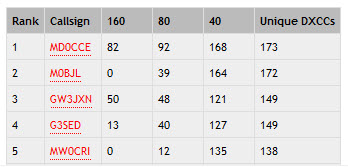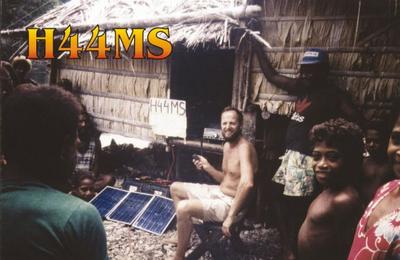DXCC Number 275 Worked for me today. H44MS Bernhard on Solomon Islands. 18.127 MHz and the band was quite quiet and not so many in the pile up and with the propagation just giving me the edge over other callers.
Solomon Islands has been “one that got away” so many times so pleased to get Bernhard in the log.
Category - Blog
Introduction – What is Club Log? Club Log is a web-based application which uses a database to analyse amateur radio log files, which are uploaded in the common ADIF format. Using the logs, it is possible to build band-mode league tables of amateurs’ QSOs, provide efficient log search tools and create most wanted lists for DXCC entities (both over all time and in recent history, or by mode for example). Also, Club Log can give back to its users the ability to find “wanted” DX spots, and other analysis of their logs which might be hard to do with normal logging software.
Club Log is an experiment in providing these features in a club or society context, ie. competitive but within a circle of members rather than just world-wide (although Club Log can also do that). The original idea was to automate DXCC league tables for the Cambridge University Wireless Society.
Club Log is also not some things! It isn’t an award scheme, it isn’t valid for ARRL DXCC (since it’s not validated) and it doesn’t provide QSO confirmations. For all those things, please check out Logbook Of The World.
Pictured above is Michael G7VJR. You can find out more here: http://www.clublog.org/
 I have been using Club Log for some time now, it is a great tool and very versatile, let me explain. Registration just couldn’t be easier, anyone can register and are welcome to join in. Uploading logs is simple to do just click on Upload in the tool bar for the upload window, once you have browsed your hard drive for the ADIF just Send and add to your callsign.
I have been using Club Log for some time now, it is a great tool and very versatile, let me explain. Registration just couldn’t be easier, anyone can register and are welcome to join in. Uploading logs is simple to do just click on Upload in the tool bar for the upload window, once you have browsed your hard drive for the ADIF just Send and add to your callsign.

Be sure that if you are uploading DX’pedition logs that you tick “no” for “show in leagues”. DX’pedition logs are important to get as much data as possible into the database. But are not required for the tables which should be used for operator calls only. 
As you can see above, the DXCC League tables can be filtered for Mode selection, Worked or Confirmed and by Date filter for 2009, Last 12 months or 36 months. Click on generate tables and then you get the league as seen below. 
 Club Log is great for club events such as the Chiltern DX Club’s “LF Challenge” which takes place every March as you can see here the database can be used to filter bands and dates to make it fun to view the table as the challenge developes over the weeks.
Club Log is great for club events such as the Chiltern DX Club’s “LF Challenge” which takes place every March as you can see here the database can be used to filter bands and dates to make it fun to view the table as the challenge developes over the weeks.
A brilliant tool that is under ongoing development by its author Michael G7VJR. This all adds a great new dimension to statistics. Thank you Michael and good luck for the future of this exciting project.
A quiet week this week after the hectic CQ-WPX SSB contest last weekend. 9M8Z and 9M6XRO logs were uploaded onto LoTW on Monday and all QSL cards received so far have been replied to. A mailing of 150 letters was posted out on Tuesday.
I was happy this morning to receive the QSL from HK0B/HK3JJH Pedro from his activity from San Andreas Island. A new one for me and number 268 DXCC Confirmed!
QSL via M0URX, Direct, Bureau or LoTW.
LoTW uploaded up to 30/03/09
Update 30th March: Well, the contest is over for another year. 2375 QSOs after dupes and 6.4 Million points, but that’s nearly 1000 QSOs down on last year, and nearly 2 million points less. Conditions were not good this year on 15m, which explains the lower score.
Update 24th March: “I am currently in Sarawak, 9M8, and operating ‘holiday style’ using an Optibeam OB-17-4 at 75ft. This antenna has 3 elements on 40m (coil loaded), 4 full size monoband elements on 20m, 4 on 15, and 6 on 10m, and by all accounts I have a big signal in Europe. 10m opened up as far west as Cyprus on Sunday though I doubt I’ll be working into the UK on that band.
I was on 20m last evening and it was good to work a number of CDXC members, plus a few UK calls I did not recognise.
I had planned to be more active from here on 40m but had not taken into account the fact that sunset is now around 1800z in UK – that’s 2.00am here, and for various reasons it has not been possible to be on yet at times when the band is likely to be open to Western Europe.
I will try to be on 40m tonight (Tuesday), Wednesday and Thursday, from about 1630z onwards. My preferred freqs are 7088 or 7078, but I may have to go elsewhere if those are busy of course.
I should be on 20m before 1630 but will QSY to 40m at 1630.”
Update 19th March Steve writes: I was planning to travel to Sarawak for the CQ WPX SSB contest next weekend, but there has been a slight change of plan. I have been asked to give a presentation on DXpeditioning at an ‘Amateur Radio Roadshow’
being held by MCMC, the Malaysian licensing authority, this Saturday, so I will be travelling early on Saturday morning instead. I’ll probably give a short talk and show an excerpt from the 3B7C DVD.
I should therefore be active on the bands as 9M8Z most evenings (afternoons, GMT) and I look forward to working you all from Sarawak.
Look for me on 20m SSB early afternoons, then 40m SSB later on.
VP8KF QSL Via G3VPW
Chris Colclough G1VDP http://www.g1vdp.com
More informationon the Strumblehead DX & Contest Group at: http://www.mc0shl.com
For me, a QSL card is more than just a confirmation of a 2 way radio communication. It can tell someone a lot about you and your station and your interests in the hobby.
So what do you put on your QSL card? Think about the design you want, it will be only as good as your imagination allows. How about a photo of you in the radio shack, or at the helm of the newly furbished club station or a photo of you in pursuit of another hobby? Or a photo of that tower and the SteppIR at the top of your garden!
Remember that your QSL card may be used by others to claim awards so you should always remember to put on all relevant information. For IOTA claimants the IOTA number and the Island  name MUST be printed on the QSL card. NOT hand written. I may live in land locked Central England but we are IOTA Reference EU-005 Great Britain Mainland and this MUST be on my QSL card to be valid for an award claim. Your IARU Locator number, WAB square, Longitude and Latitude, CQ Zone, ITU Zone, Station Equipment are all as useful and as important as the QSO report panel box, your callsign and name on the QSL card.
name MUST be printed on the QSL card. NOT hand written. I may live in land locked Central England but we are IOTA Reference EU-005 Great Britain Mainland and this MUST be on my QSL card to be valid for an award claim. Your IARU Locator number, WAB square, Longitude and Latitude, CQ Zone, ITU Zone, Station Equipment are all as useful and as important as the QSO report panel box, your callsign and name on the QSL card.
On the left is the new QSL design for Oliver Bross MWØJRX, Oliver is a keen photographer and with the help of Max ON5UR, Oliver has one of the most excellent QSL cards i have seen.
QSL Via MWØJRX
If you need any help with design and printing your QSL card please drop either myself or ON5UR Max an email and we will gladly help you.
If you are in the UK I have about 250 International Reply Coupons for sale at 60p each + P&P depending on quantity please email me for more information using “Contact M0URX” in menu.
Recently I have noticed some problems regarding incoming QSL cards.
Russia – I am receiving DAILY QSL cards from Russia with no postal contribution. I will no longer pay for your countries refusal to send $ or IRCs. In future ALL QSL cards without postal contribution will be sent Via Bureau. The main problem is some Russian QSL Managers. Incredibly today I received 6 letters from Russia and not one with any postal contribution. Ask yourself how am I supposed to pay for the postage?
Just incase the money has been stolen please seal the envelope on all 4 sides with sticky tape. I will open carefully here.
U.S.A. I am receiving a lot of letters from U.S.A. with insufficient postage stamps covering up to 10g only. Many letters are 11g or 12g and are subject to higher postal rates. Also when you send a Self Addressed Envelope please remember you MUST write United States of America on the envelope or it will be returned back to me insufficient address.
Thanks for your attention!
9M6XRO John’s latest email tells us that he is planning once again to be in
I can now confirm my
Looks like I will also have the option of operating from










